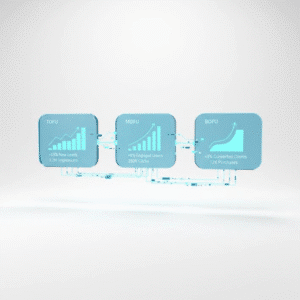
Ever end the quarter wondering where your AWS marketing budget went?
Random webinars. Scattered social posts. Generic email blasts.
You’re not alone.
Here’s what top AWS partners know: Marketing activities don’t create revenue. Marketing systems do.
This playbook isn’t theory. It’s field-tested across 40+ AWS partner transformations from Bangalore to Dubai to Jakarta. Use it as your reference guide for building a marketing calendar that actually drives pipeline: from early-stage AWS partnerships to mature joint GTM programs a must-read if you want to improve AWS lead generation and accelerate sales outcomes.
The Hard Truth About AWS Partner Marketing
Most partners treat marketing like throwing pasta at the wall. They launch campaigns, hope for leads, and wonder why their MDF requests get rejected.
Winners think differently.They see marketing as revenue acceleration architecture. Every campaign has intent. Every piece of content creates value. Every quarter builds on the last.
The difference? A calendar system that works before, during, and after execution the foundation of the best AWS marketing strategies

Part I: PRE-Execution Foundation (3-Week Runway)
The 90-Day Rule: Win Before You Launch
Smart partners know 90% of marketing success happens in the planning phase.
Campaign failures aren’t execution problems. They’re foundation problems.
Week 3: Market Intelligence & Alignment
Start with brutal honesty about your current state.
The CUSP Reality Check:
- What was your actual MQL-to-SQL conversion rate last quarter? (Not what you hoped: what happened)
- Which AWS use cases generated the most pipeline value?
- What’s your average deal size when AWS is involved vs. solo deals?
Map your Ideal Customer Profile against AWS priorities:
- Companies with existing AWS workloads expanding services
- Organizations planning cloud migrations in your region
- Firms hiring for cloud roles (strong demand signal)
Pro Tip from Mumbai Market: Indian enterprises often have 6-12 month evaluation cycles. Build your calendar around their fiscal planning periods (April-March). Q4 budget approvals happen in January-February.
Week 2: AWS Partnership Alignment
Don’t plan in isolation. Your AWS account team has intelligence you need.
The Partnership Sync Meeting (60 minutes):
- AWS regional priorities for the quarter
- MDF budget availability and application deadlines
- Solution Architect availability for joint activities
- Upcoming AWS events where you can co-participate
Schedule this meeting 21 days before quarter-start. AWS teams plan quarterly too as this is key for AWS sales and marketing alignment.
Week 1: Calendar Architecture
Build your 90-day marketing calendar like a pipeline funnel:
TOFU (Top of Funnel) – Weeks 1-4:
- Thought leadership content
- Industry webinars with AWS speakers
- SEO-optimized blog series
- Social media campaigns
MOFU (Middle of Funnel) – Weeks 5-8:
- Technical deep-dives with Solution Architects
- Case study launches
- Demo series for qualified prospects
- Nurture sequences for early-stage leads
BOFU (Bottom of Funnel) – Weeks 9-12:
- Account-based campaigns for key prospects
- POC programs with AWS support
- Executive briefings
- Customer reference programs
The Pre-Execution Checklist
Market Foundation Complete:
- ICP mapped against AWS regional priorities
- Competitor analysis of other AWS partners in your space
- Previous quarter’s conversion data analyzed
- Sales team aligned on lead qualification criteria
AWS Partnership Secured:
- Quarterly sync meeting completed with AWS team
- MDF application pipeline identified (3-5 potential requests)
- Solution Architect time pre-committed for key campaigns
- Co-marketing opportunities calendar-blocked
Content & Campaign Ready:
- 90-day editorial calendar populated
- Message testing completed with existing customers
- Creative assets in production pipeline
- Lead scoring and routing systems tested
Part II: During-Execution Operations (The 90-Day Sprint)
The Weekly Rhythm Principle
Marketing campaigns die in the execution gaps. Weekly visibility prevents quarterly surprises.

Campaign Launch Protocol (Weeks 1-4)
The Monday Morning Standup:
Every marketing initiative gets 15 minutes of focused review:
- What launched last week?
- What’s the early performance data?
- What’s blocked and needs intervention?
- What launches this week?
Sample AWS MDF Request Script:
“Hi [AWS Partner Manager], we’re launching our Q2 ‘Cloud Cost Optimization’ campaign targeting mid-market manufacturing in Tamil Nadu. Based on last quarter’s success with similar campaigns (generated 12 SQLs, closed ₹45L pipeline), we’re requesting ₹2L MDF support for:
- Joint webinar with AWS SA (₹50K)
- Paid social amplification (₹75K)
- Content creation for 3 case studies (₹75K)
Expected outcome: 150 registrants → 25 MQLs → 8 SQLs → ₹60L pipeline. AWS asks: SA speaker time (4 hours), blog amplification, co-branded landing page approval.”
Sales Handoff Excellence (Weeks 5-8)
Marketing generates leads. Sales creates revenue. The handoff determines success.
The Lead Brief Template:
“Priority: A-level MQL
Company: [Name] – ₹50Cr revenue, 200 employees
Contact: [Name], Head of IT Infrastructure
Challenge: Migrating 200 legacy apps to cloud, concerned about costs
AWS Relevance: Currently evaluating Azure vs. AWS for primary workloads
Conversation History: Attended webinar, downloaded ROI calculator, requested demo
Next Step: Schedule technical deep-dive with our SA + AWS SA
Timeline: Decision expected in 6 weeks”
Pro Tip from Dubai Market: Middle Eastern prospects expect relationship-building before technical discussions. Schedule coffee meetings before demo calls. The investment in face-time accelerates deal velocity.
Weekly Performance Review
Track outcomes, not activities.
Ignore These Vanity Metrics:
- Email open rates
- Social media impressions
- Website page views
- Content downloads
Focus on These Revenue Metrics:
- MQLs generated per campaign
- MQL-to-SQL conversion rate
- Average deal size (AWS joint vs. solo)
- Sales cycle length (AWS supported vs. independent)
CUSP Pro Tip: The ASEAN Approach
In Singapore and Jakarta, we learned that enterprise buyers want proof before pilots. Build your MOFU content around customer success stories with specific ROI numbers. Generic case studies don’t convert. Detailed financial outcomes do.
Part III: POST-Execution Optimization (The Revenue Loop)
The 30-Day Debrief Rule
Most partners finish campaigns and immediately start planning the next one.
Winners analyze performance and optimize systems especially for AWS lead generation efficiency. 
Campaign ROI Analysis
The Hard Questions:
- Which campaigns generated the highest-quality SQLs?
- What was the actual cost-per-qualified-opportunity?
- Which AWS joint activities had the highest conversion rates?
- Where did we waste budget that could be reallocated?
Sample ROI Analysis:
Campaign: “AI-Powered Cloud Migration” Webinar Series
Investment: ₹3.5L (₹2L MDF + ₹1.5L internal costs)
Results: 287 registrants → 43 MQLs → 12 SQLs → 3 closed deals (₹85L pipeline)
ROI: 24x return on investment
Key Learning: Technical demos convert better than thought leadership
Next Quarter: Double down on demo-first content, reduce presentation slides
AWS Partnership Assessment
Rate your AWS collaboration effectiveness:
MDF Program (1-5 scale):
- Application approval speed: ___
- Funding amount vs. request: ___
- Campaign performance with AWS support: ___
Solution Architect Engagement:
- Availability for joint calls: ___
- Technical credibility with prospects: ___
- Influence on deal progression: ___
Joint Marketing Support:
- Content co-creation quality: ___
- Channel amplification reach: ___
- Lead quality from AWS sources: ___
Score below 3 in any area? Schedule alignment meeting with AWS team before next quarter it strengthens your AWS sales and marketing alignment process.
Next Quarter Acceleration
Use this quarter’s data to optimize next quarter’s approach.
The CUSP Quarterly Review Template:
What Worked:
- Top 3 campaigns by SQL generation
- Most effective AWS partnership activities
- Highest ROI content types
What Failed:
- Campaigns that missed target by >30%
- AWS requests that got rejected
- Content that didn’t resonate
What’s Next:
- Budget reallocation based on performance
- New AWS partnership opportunities
- Untested channel experiments worth trying
The CUSP Marketing Calendar Success Formula
At CUSP, we’ve refined this playbook across multiple markets: from the cost-conscious enterprise buyers in Pune to the relationship-driven business culture of Indonesian conglomerates.
The pattern remains consistent: Planning beats improvisation. Systems beat serendipity. Partnership beats going solo.
Whether you’re scaling across India’s tier-2 cities or expanding into Southeast Asian markets, this playbook adapts to your growth stage and market dynamics.
Your success isn’t determined by campaign creativity. It’s determined by campaign consistency and optimization discipline the foundation for the best AWS marketing strategies.
Your Next Quarter Starts Today
Don’t wait for the next AWS Summit to test this system. Start with your current quarter’s remaining weeks.
Remember: Marketing calendars are revenue acceleration tools, not creative exercises. The companies winning AWS joint GTM partnerships are the ones treating every campaign as a measurable business investment.
The choice is yours: continue hoping for marketing magic or start building marketing systems.
Ready to transform your AWS partnership ROI? CUSP’s execution-driven consulting helps cloud partners build systematic approaches to joint GTM success. From quarterly planning to campaign optimization, we help you turn AWS lead generation and marketing budgets into predictable pipeline.
Let’s discuss how these best AWS marketing strategies apply to your specific market and growth goals.


